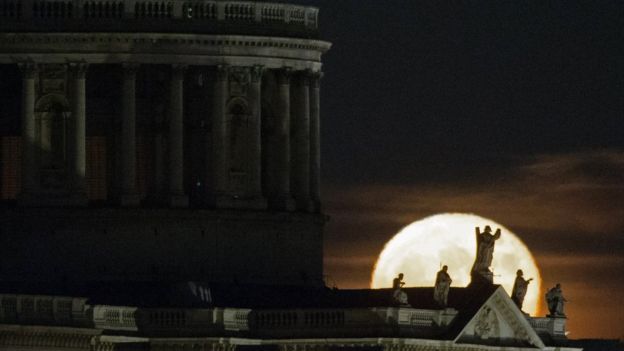
Skywatchers could catch a glimpse of a so-called “supermoon” – when the Moon appears larger and brighter in the sky.
At 15:47 GMT the Moon will appear about 7% larger and 15% brighter, with moonrise about 45 minutes later.
The phenomenon happens when the Moon reaches its closest point to Earth, known as a perigee Moon.
The Moon circuits the Earth in an elliptical or oval orbit – a supermoon occurs when the perigee Moon is also a full Moon.
Robert Massey, of the Royal Astronomical Society, said it will appear brightest at midnight – when at its highest point above the horizon.
The Met Office’s UK forecast suggests there will be clear spells this afternoon, so the supermoon may be visible.
Last year the Moon made its closest approach to Earth since 1948 – it won’t be that close again until 25 November 2034.
Nasa has called this weekend’s sighting the first in a “supermoon trilogy”over the next two months, with others to come on 1 January and 31 January.
December’s full Moon is traditionally known as the cold Moon.
This full Moon on Sunday afternoon – when it sits opposite the sun in the sky – will be 222,761 miles from Earth, closer than its average 238,900 miles.
Moon illusion
Mr Massey says the “most spectacular views” will come during moonrise, on Sunday, and moonset, on Monday morning.
This is because an optical illusion, known as the Moon illusion, makes it look unusually large when it appears close to the horizon.
Mr Massey said: “It’s a nice enough phenomenon.
“You won’t necessarily think that it’s huge. It will appear a bit bigger than usual, but don’t expect it to look five times bigger.”
 Image copyrightAFP
Image copyrightAFPThis Moon’s elliptical orbit means that its distance from Earth is not constant but varies across a full orbit.
But within this uneven orbit there are further variations caused by the Earth’s movements around the Sun.
These mean that the perigee – the closest approach – and full moon are not always in sync.
But occasions when the perigee and full moon coincide have become known as supermoons.
Advertise with the mоѕt vіѕіtеd nеwѕ ѕіtе іn Antigua!
We offer fully customizable and flexible digital marketing packages.
Contact us at [email protected]

















